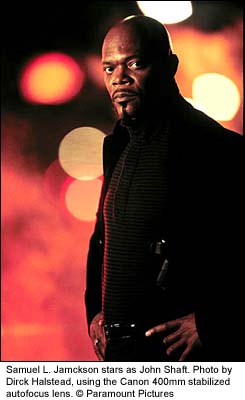|
|
|
|
A Review of the Canon Long Stabilized Lens on the Set by Dirck Halstead |
 |
|
Late last year, I was commissioned by Paramount Pictures to do a publicity shoot on the set of SHAFT. I have been doing movie shoots for years, in addition to my photojournalism. Two things occurred to me when I first began working on movie sets: movie publicity work requires very special disciplines, and you quickly realized you're the least important person on the set.
One particular challenge is shooting at
night. We started about 6pm, because the cameras don't roll until after
dark. A movie set is lit for one angle - that of the movie camera. Being
a few degrees off from the position of the Panavision camera (for which
that take is lit) can leave you with an unworkable scene for the still
camera. All this is difficult enough, then throw in a black actor (Samuel
L. Jackson), dress him in a black suit, and all of a sudden
I spent two nights on the set in lower Manhattan, last December. After the first night, I knew I was not going to get anything as good as the unit photographer, Eli Reed, let alone something unique. If I was to earn my pay, I had to come up with a solution fast. Creating my own lighting was essential. I had to get backlight on the subject, to give separation. My parallel challenge was not to disrupt the main unit as they filmed. The set was a block-long area in midtown Manhattan that had been shut down for filming. I realized I needed to set up a long lens that would compress the "natural" light from street and traffic lights; then, add hot lights (keeping the ratios under control - the difference between the ambient exposures needed to let the traffic lights register as globes on the film, and whatever key lights I set up). Taking a look at my exposure meter, I knew I would be working at something like 1/30th of a second at f 2.8, using a 400mm lens, which I considered was the focal length I needed. This was on Kodak EPJ320, pushing 1/2 stop. Even with the camera on a tripod, I knew I was going to be on thin ice. Canon had just introduced their new 400 and 600mm auto-stabilized lenses, which use a microprocessor controlled system, employing two independent vertical and horizontal motion sensors to monitor lens movements. I contacted Chuck Westfall, Canon's tech support manager, about my problem and he sent me one by messenger. Now, I would be able to get a steady picture with the telephoto lens at a relatively slow exposure. The gaffers on the set helped me set up two hot lights to give me my key lighting. One was a 1K light, bounced off a white reflector about 6 feet from the subject. A second 1K light was positioned about 75 feet behind the subject to give that needed separation. Between takes I was able to get Mr. Jackson to pose for me about 50 feet away from the main set. I ran two rolls of film through the camera in less than 3 minutes, and we were done. After I thanked him for his time, he looked at me and said "That's It?" So, what's the big deal with the stabilized lens? Well, if I had shot a normal 400mm lens at 1/30th, even on a tripod, I would have been very lucky to get a sharp frame. Just the shutter bounce at that focal length would have been enough to blur the picture. Canon has added a new function that allows the IS super-telephoto lens to detect whether or not it's being used on a tripod. If it is, the lens goes into a new super-sensitive IS mode that's capable of correcting even subtle movements such as the slap of the camera's reflex mirror prior to exposure. This is precisely the capability I needed. For more information, visit Canon's website at http://www.usa.canon.com. |
|
 My
job is always to read the script first, then envision an image to capture
the essence of the story. I wait and watch, for that moment when the all
the essential elements come together. It's a very dicey proposition. You're
dealing with "talent" and production problems over which you have no control.
My
job is always to read the script first, then envision an image to capture
the essence of the story. I wait and watch, for that moment when the all
the essential elements come together. It's a very dicey proposition. You're
dealing with "talent" and production problems over which you have no control.